Text
Finding Time and Defining Emotions: Interview with Joshua Byron
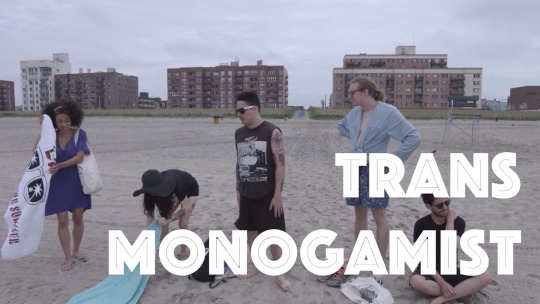
Joshua Byron is a nonbinary storyteller living in New York. They co-created Trans Monogamist with Alfredo Franco and Artless Media. Previously, they have produced 19 film works that have screened at Sarah Lawrence, the Indianapolis LGBT Film Festival, and Secret Project Robot. They occasionally write essays about dating.
This interview, conducted at an overpriced Williamsburg coffee shop, was edited to unfortunately not include the laughs, espresso maker noises, and Britney Spears music that brought life and casual atmosphere to the act... but enjoy anyway


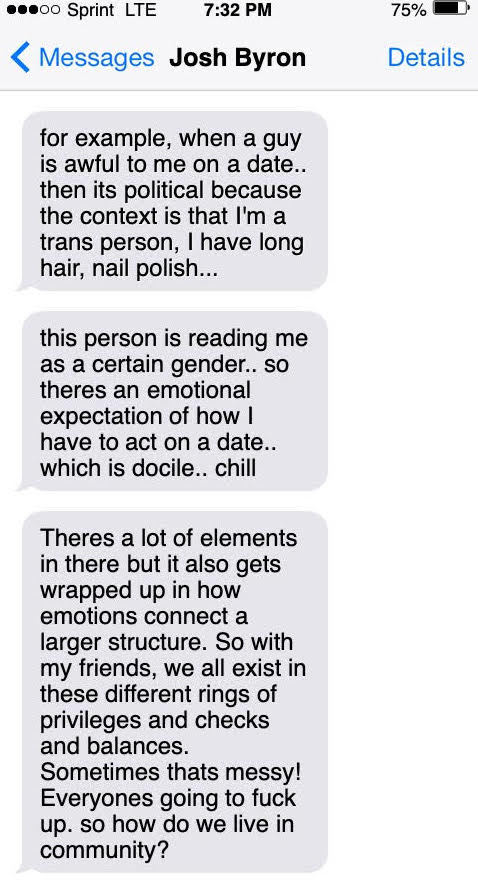
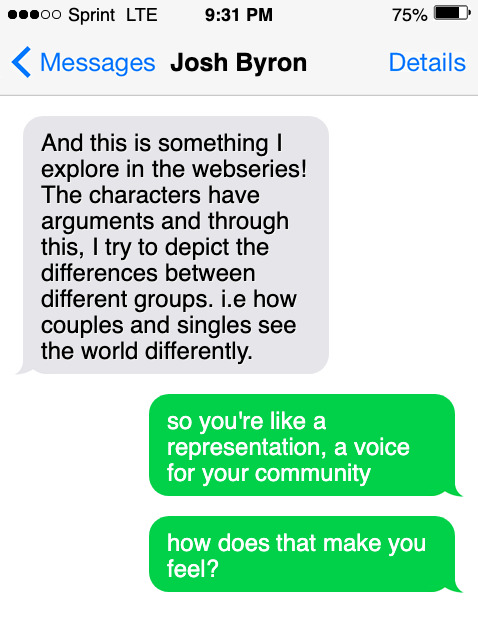
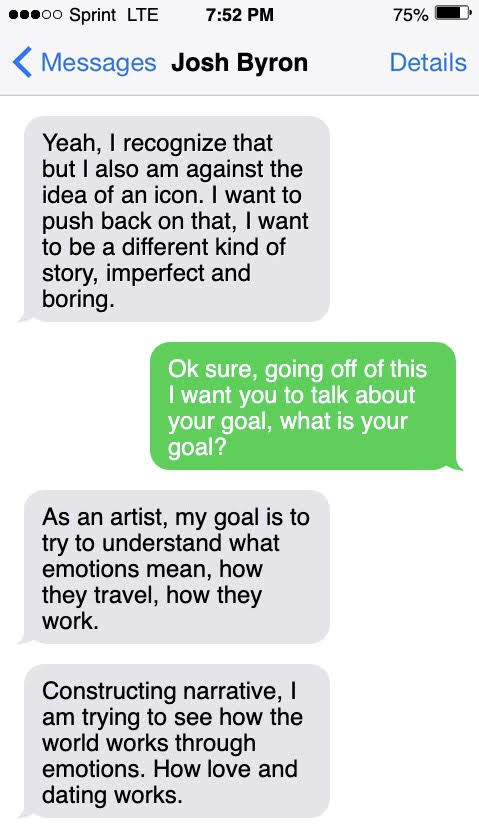



A few days later...

Please support Joshua’s artistic endeavors and be sure to check out their webseries
0 notes
Photo
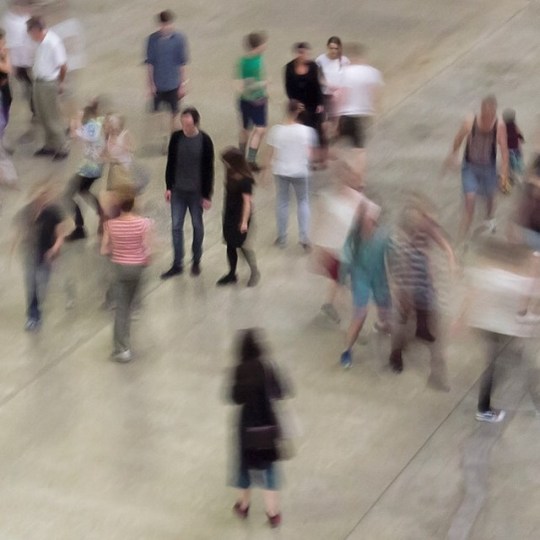
Resuscitation of the Authentic: Art Against Documentation. New & first essay posted on my website, link is in bio. Image: Tino Sehgal, These Associations 2012 (at New York, New York) https://www.instagram.com/p/Bz8KOaWgtTi/?igshid=1iszmmyc866u9
1 note
·
View note
Text
Resuscitation of the Authentic: Art Against Documentation
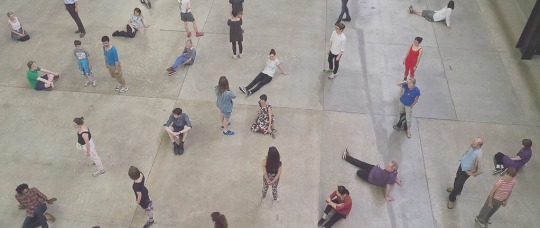
In the summer of 2013, the light and space artist, James Turrell requested that visitors of his exhibition at the Solomon R. Guggenheim Museum, refrain from taking any photographs. Turrell, who had created a new installation, Aten Reign (2013), for this exhibition, believed that glowing mobile devices would impede on the meditative atmosphere of his work, which sought to recast the rotunda of the Guggenheim into a volume filled with shifting artificial light, a soft diffusion of pink, blue and yellow. In spite of, or perhaps because of Turrell’s provocative request, more than 5000 photos from this exhibition appeared on social media platforms such as Instagram and Facebook, with the hashtag: “Turrell.” Indeed, in 2013 by the close of the show, this exhibition became the “most Instagrammed” in Guggenheim history. A similar event occurred in 2012 when Tino Sehgal, an artist known for his works featuring live encounters, was commissioned by the Tate Modern for their Unilever Series (2012), where he introduced a series of performances titled These Associations (2012). Sehgal, too, requested that the performances not be photographed or documented in any way, in keeping with his larger investment of being strictly against producing the art object. However, much like the Turrell exhibition, with a simple google search, one can find on social media platforms such as Flickr and Vimeo, countless numbers of photographs, videos, and posts that users have uploaded from their experience of these performances.
These artists rehearse an attachment to singularity and presence that characterizes not only much of contemporary performance art, but also one that is prominent in marketing practices. Companies advertise their products through the idea of the authentic experience-one that produces an idea of desire through singularity. In marketing, the inauthentic is something amnesic, prepackaged, and monotonous. Modern day companies use social media platforms like Instagram and Twitter to produce advertisements that may seem more personable, “the impulse to capitalize on popular trends and reach audiences on their own terms often drives brands to improperly use cultural idioms or otherwise present themselves and their products in a manner deemed "inauthentic”“. What is at stake in such a resuscitation of authenticity? Might this new fetish for the authentic function as being a significant post-digital cultural formation? Marketingland provides a rundown of how to be an "authentic brand” through what they’re claiming to be behavior analysis science insights to “help brands create authentic content that engages audiences without inspiring cynicism and mistrust, ” all the capital without the criticism. This begs the question of attachment: is there an attachment of the authentic to the real? It is clear that there is a relationship that is unavoidable, one that associates the authentic to the self-made. The inauthentic seems to be identified as a threat to individuality and is understood as either machine-made or being attached to technology.
The authentic is one that elevates the human above the machine. As Ruskin understands it, the machine is something that can only make inauthentic things - dead things that communicate their deadness to those who use them. However, this doesn’t account for the human behind the machine. In Wretched of the Screen, Hito Steyerl addresses this question of the human behind the machine. The situation an image is created or reproduced in reveals more than the context or appearance of the image. Through sharing, screenshots, downloads, and reposts, the image or digital file reveals the conditions of their marginalization and the social forces that lead to their circulation.
Arguing against Ruskin’s “the machine can only communicate deadness”, the human behind the machine is one that communicates a situation, a contemporary human condition. Through the use of digital media, we are communicating life. Through the performance of a photo, the individual is communicating place and representation. A selfie is a means of saying “I was there”, a production of evidence (connected to surveillance culture and race politics). Visual culture is a social relationship through images. The image is a product of social relations that produces contradictory side effects. The image has become ideological, it teaches us what to think and additionally influences our choices and how we interact socially. The power of spectacle culture captivating/overwhelming is self-validating of commodity culture and continues to establish itself as a driving force in determining both private and public desires This leads me to ask: can an experience be real/authentic without the production of an image?
Wil S. Hylton, "How James Turrell Knocked the Art World Off Its Feet," The New York Times, June 13, 2013, accessed March 02, 2018, http://www.nytimes.com/2013/06/16/magazine/how-james-turrell-knocked-the-art-world-off-its-feet.html.
TEDxTalks, YouTube, March 02, 2016, accessed March 07, 2018, https://www.youtube.com/watch?v=8DLNFDQt8Pc&t=175s.
Sean Santiago, "Inside the Apartment of An Instagram Celebrity," Inside the Apartment of a #Selfie-Made Celebrity, June 5, 2015, accessed March 07, 2018, https://www.refinery29.com/jiajia-fei-guggenheim-interview.
Ignacio Villarreal, " Tate unveils first live commission in The Unilever Series created by the artist Tino Sehgal," Artdaily.org, July 24, 2012, accessed March 02, 2018, http://artdaily.com/news/56696/Tate-unveils-first-live-commission-in-The-Unilever-Series-created-by-the-artist-Tino-Sehgal.
Flickr search "Turrell 2013": https://www.flickr.com/search/?structured=yes&text=james%20turrell%202013
Flickr search "Sehgal These Associations": https://www.flickr.com/search?text=tino%20seghal%20these%20associations&structured=yes
#essay#art#authenticity#james turrell#performance#media#marketing#arts criticism#article#tino sehgal
1 note
·
View note